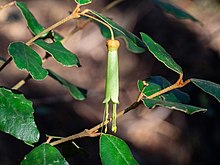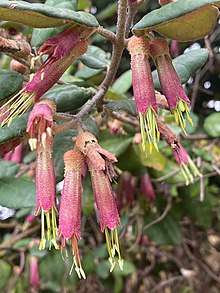Correa lawrenceana var. latrobeana
Correa lawrenceana var. latrobeana is a variety of Correa lawrenceana that is endemic to south-eastern Australia. It is a shrub or small tree with elliptical to egg-shaped leaves and cylindrical, greenish-yellow or reddish-mauve flowers arranged singly or in groups of up to seven in leaf axils or on the ends of branchlets.
| Correa lawrenceana var. latrobeana | |
|---|---|
 | |
| In the Nadgee Nature Reserve | |
| Scientific classification | |
| Kingdom: | Plantae |
| Clade: | Tracheophytes |
| Clade: | Angiosperms |
| Clade: | Eudicots |
| Clade: | Rosids |
| Order: | Sapindales |
| Family: | Rutaceae |
| Genus: | Correa |
| Species: | |
| Variety: | C. l. var. latrobeana |
| Trinomial name | |
| Correa lawrenceana var. latrobeana | |

Description
Correa lawrenceana var. latrobeana is a shrub that typically grows to a height of 3 m (9.8 ft) or a tree to 16 m (52 ft). Its leaves are elliptical to egg-shaped, arranged in opposite pairs, 24–65 mm (0.94–2.56 in) long and 7–34 mm (0.28–1.34 in) wide and covered with felt-like, cream- to rust-coloured hairs on the lower side. The flowers are arranged singly or in groups of up to seven in leaf axils and on the ends of branchlets on a stalk 7–25 mm (0.28–0.98 in) long. The calyx is cup-shaped, 4–7 mm (0.16–0.28 in) long, covered with woolly, rust-coloured hairs and with a wavy rim. The corolla is cylindrical, 25–30 mm (0.98–1.18 in) long and greenish-yellow or reddish-mauve. Flowering mostly occurs in spring.[2][3][4]
Taxonomy
This correa was first formally described in 1856 by Samuel Hannaford from an unpublished description by Ferdinand von Mueller. It was given the name Correa latrobeana and the description was published in Jottings in Australia: or, Notes on the flora and fauna of Victoria, with a catalogue of the more common plants, their habitats, and dates of flowering.[5][6] In 1998, Paul Wilson reduced it to a variety of C. lawrenceana as C. lawrenceana var latrobeana in the journal Nuytsia.[7][8]
Distribution and habitat
This correa variety grows in forest or dense scrub, often along streams south from the Goulburn district in New South Wales to eastern Victoria where it is found n places including Buchan, Mount Buffalo, Mount Baw Baw, Warburton and Healesville then extending to the south-west of Melbourne as far as the Otway Ranges.[3][4][7]
References
- "Correa lawrenceana var. latrobeana". Australian Plant Census. Retrieved 13 July 2020.
- Wilson, Paul G.; Wilson, Annette J.G. (ed.); Bolton, P.E. (ed.). "Correa lawrenceana var. latrobeana". Australian Biological Resources Study, Department of Agriculture, Water and the Environment: Canberra. Retrieved 12 July 2020.CS1 maint: extra text: authors list (link)
- Duretto, Marco F. "Correa lawrenceana var. latrobeana". Royal Botanic Gardens Victoria. Retrieved 12 July 2020.
- Crayn, Daryn M. "Correa lawrenceana var. latrobeana". Royal Botanic Garden Sydney. Retrieved 12 July 2020.
- "Correa latrobeana". APNI. Retrieved 12 July 2020.
- Hannaford, Samuel (1856). Jottings in Australia: or, Notes on the flora and fauna of Victoria. With a catalogue of the more common plants, their habitats, and dates of flowering. Melbourne: J.J. Blundell & Co. pp. 40–41. Retrieved 13 July 2020.
- Wilson, Paul Graham (1961). "A taxonomic revision of the Genus Correa". Transactions of the Royal Society of South Australia. 85: 97. Retrieved 13 July 2020.
- "Correa lawrenceana var. latrobeana". APNI. Retrieved 12 July 2020.